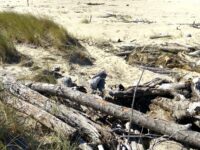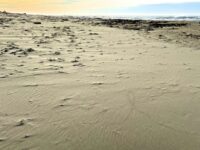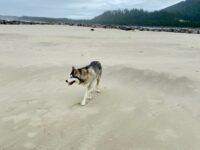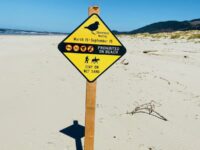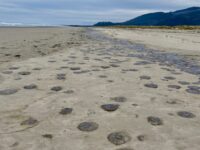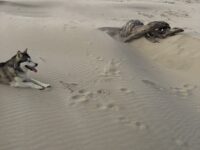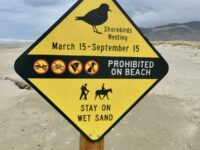Mile 289 Report
Kincheloe Point, South Jetty Tillamook River
January 28, 2019
There were a couple of firsts on this survey.
Report Details
There were a couple of firsts on this survey. This is the first one we have done after missing the last equinox and solstice time slots. It was good to be back at it. We can blame bad weather, high surf, and a nagging leg injury for the delay. It was also the first time that we have seen a large group and bald eagles working on a carcass. There must have been over a dozen of the big birds. And lastly we saw a single gull over something in the surfline. It turned out to be a possum. How did it get into the ocean? Maybe an eagle grabbed it and let it go over the ocean.I do have to comment on the fencing and restrictions that are in force during the spring through fall. This is for plover protection. There are small signs directing people and their animals away from the fenced area and to the wet sand. BUT on this sign is a dog icon with an slash throught it. It is off limits to all dogs. I searched for "Bayocean Spit Hike." There are pages of sites. All talk about a great family hike. I only saw 1 that said dog restrictions are in effect. But it said dogs must be on leashes. This hike is widely promoted, but many famlies and individuals with dogs will be in violation. If you really want to protect nesting birds, put up large signs saying all dogs must be leashed. And post a phone number to report violations. The current situation is foolish and wrongheaded.
Conditions
Temperature: 54 F. Cloud Cover: Sunny. Tide Level: 2.0 feet.
Human Activities
We saw nobody after mile 287. The people in the 8 cars in the spit parking lot must have been using the road on the bay side of the spit.
Concerns
Vehicles
Notable Wildlife
Multiple bald eagles, both mature and immature were feeding on the carcass of a mammal. Nearby the crows were waiting. On the return trip, 2 large dark birds with white underwings circled the carcass. The eagles flew off allowing the other 2 to land and have at what was left of the mammal. I suspect it was a pair of osprey.
Beached Birds
Total dead birds: 2. One was a northern fulmar. The other was a single wing from a smaller alcid group bird. I would guess a rhinoceros auklet.
Driftline Content
Small rocks, Seaweeds and seagrass, Shells, Animal casings (e.g., crab, shrimp molt), Wood pieces, Land-based debris (picnics, etc.), Marine debris (plastic, styrofoam, etc. washing in from the sea), Styrofoam, Ocean-based debris (from fishing boats, ship trash, etc.). The beach was fairly clean. We have seen it much worse. There was some of the usual plastic bottles, containers, and wrappers. There were short sections of crab rope as well as 1 commercial crab float. The largest item was a blue plastic 55 gallon drum. It was partially filled, but I would guess it was sea water. The high tides and surf deposited lots of wood, rocks, shells, and kelp.
New Development
none
Man-made Modifications
none
Natural Changes
As usual Mile 289 has no sign of erosion even after big tides and swells. No surprises
Actions & Comments
For decades we have seen mile 289 expand to the west as sand gets deposited. Last year we noted that half way down the spit in the area of the former Bayocean community, erosion was affecting the foredune. Experts who monitor the south jetty predicted that as the jetty eroded and became shorter, the spit near the jetty would accumulate sand, but the mid section of the spit would see erosion. This year there is major erosion on the foredune near Bayocean. It must be a 15 to 20 foot drop at the highest dune. But there has been no net loss of beach since the mid 80's. The one very noticeable taller dune (from Bay City esp) between Cape Meares and the forested dunes was right next to the wet sand in 1985. Today it sits well back from wet sand.




Report Images
All Mile 289 Reports
Mile 289
Kincheloe Point, South Jetty Tillamook River
This mile is not surveyed 4 times a year since it became a designated bird nesting area.
ollikainen
Mile 289
Kincheloe Point, South Jetty Tillamook River
There is no trace of nesting bird protection.
ollikainen
Mile 289
Kincheloe Point, South Jetty Tillamook River
September 15 ended the nesting bird restrictions on mile 289.
ollikainen
Mile 289
Kincheloe Point, South Jetty Tillamook River
I saw so many different types of birds along the jetty, I'm no bird expert but I thought I saw pelicans, herons, cormorants, and sea gulls.
EJD
Mile 289
Kincheloe Point, South Jetty Tillamook River
Mile 289 is again restricted due to bird nesting.
ollikainen
Mile 289
Kincheloe Point, South Jetty Tillamook River
This survey was all about the jelly fish that covered the most recent wrack areas.
ollikainen
Mile 289
Kincheloe Point, South Jetty Tillamook River
This is a partial survey.
ollikainen
Mile 289
Kincheloe Point, South Jetty Tillamook River
The signage is up again keeping all dogs off Mile 289.
ollikainen

